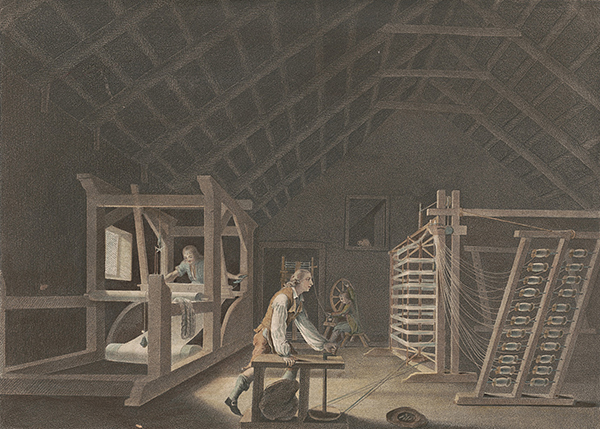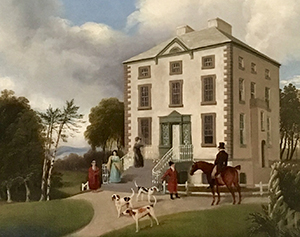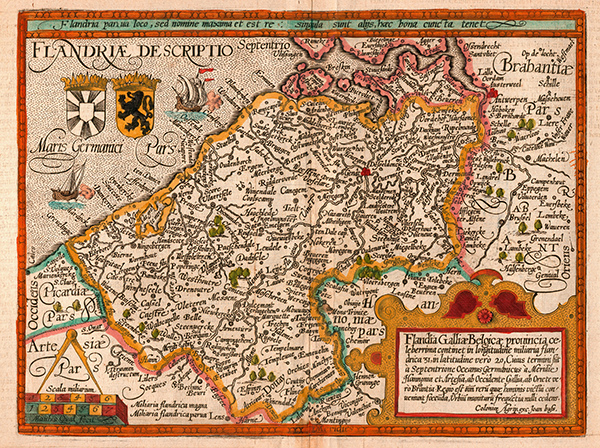The enigma of the ‘French’ linen-weavers of Cootehill and Swinford
Published in 18th-19th Century Social Perspectives, Features, Issue 6 (November/December 2016), Volume 24RECOVERING THE ‘HIDDEN HISTORY’ OF AN ÉMIGRÉ COMMUNITY
By Michael Brabazon
Petit, Casinan, Visard, Douepurty, Petin, Arry, Tallon—the French names stood out in sharp relief against the familiar Nolans, O’Connors, Mellets and Gallaghers. The more I looked, the more I found: Royan, Callary, Pordon, Byenn, Caffel, Mossily. I was looking for my great-great-great-grandmother, Leuce Teat, a native of Cootehill, Co. Cavan, who settled in Swinford, Co. Mayo, and was hoping to find an explanation for her foreign (French?) Christian name. What I found in the nineteenth-century parish records for both places were clues to the hidden history of an émigré community. ‘Huguenots’ was the first thought, but these names were on Catholic registers, not Protestant, and not in a select colony but as an integral and integrated part of the host community. Most Huguenot names in Ireland are known and listed; most of those on these Catholic registers are not on those lists. How can this enigma be explained?

Above: ‘Winding, Warping, with a new improved warping Mill, and Weaving’—one of twelve engravings published by William Hincks in 1783 to illustrate the various stages in the preparation of linen, from sowing the flax seed to the sale of the bleached cloth. (Irish Linen Centre and Lisburn Museum)
Huguenots and linen
The Huguenots were French Protestants who arrived in Ireland to escape religious persecution in the wake of the revocation of the Edict of Nantes in 1685 by King Louis XIV, although there were previous but smaller settlements before then. Famed for their well-honed trades and skills, the Huguenots excelled as bankers, goldsmiths and textile-workers. The Irish linen industry was still in its nascent stage when the French arrived, to be quickly transformed by the initial weaving community they established in Lisburn, Co. Antrim. The fine linen they produced was to became world-renowned.
As the revitalised linen industry became established in towns across north-east Ulster, the French weavers were not numerous enough to satisfy the growing demand, so the trade spread to the Irish Protestant community and then the Catholic. New locations sprang up across the country, spreading into north Mayo as well, centred on Castlebar. In County Cavan, the Coote family, who had intermarried with the Hill family, created the town of Cootehill in the early 1700s specifically as a linen-producing town, and by the end of the eighteenth century it had become the major centre for the linen trade in Ireland. The bulk of the Cootehill workforce was Presbyterian. These Scots-Irish were already linen producers before the arrival of the Huguenots and then refined their skills in line with the new, improved, quality of the material. As the town prospered and attracted weavers, flax-spinners and bleachers from across Ireland, its monoculture developed into a veritable Irish melting-pot.
The political dimension of the Cootehill community began in the 1770s with the formation of the Volunteers, recruited across Ireland in the wake of the American War of Independence. The Presbyterians—oppressed, like the Catholics, by the Penal Laws—warmed to the American ideal of national liberty, and the Cavan Volunteers became a focal point for their aspirations. The corps was eventually disbanded, but the political fervour lingered, especially in Cootehill. The town became a hotbed of discontent and, after the foundation of the United Irishmen in 1791, a recruiting ground for the organised republican movement. The home of one of the town’s leading families, the Brabazon Brunkers, was even used as the meeting place for a United Irish-dominated Freemasons’ lodge. A combined force of Cavan and Monaghan United Irishmen was one of the last to battle Crown forces in 1798, when they vainly tried to prevent army reinforcements from reaching Castlebar at the Battle of Rebel Hill, outside Bailieborough.
Ireland’s opportunity, Flanders’s difficulty
The Irish linen industry took off in the 1780s, with demand fuelled by the rising English mercantile middle classes. Just as the original expansion had necessitated a vastly increased workforce, so too the late 1780s required even greater numbers. There were plenty of flax-growers but the skills of spinning and weaving could not be acquired overnight; training would normally take place within the family, like all traditional cottage crafts. Success in one place often means a downturn somewhere else—in this case in Flanders, the ancient textile centre of northern Europe and heretofore the major linen-producer on the Continent. Owing to its early predominance, linen-workers in Flanders—Flemish and French (Walloon)—had dramatically increased in number. Now the sudden change of fortune spelled financial ruin for them. While the Flemish population could migrate with relative ease into the Dutch Republic and/or north Germany, the French had more limited options.
Meanwhile, a boat-ride away was an Ireland crying out for their skills, with a Catholic community to welcome them, and one, moreover, with which they shared certain cultural and historical links. There was a long-standing tradition of Irish Catholic military service in the Low Countries, as well as the Irish colleges at Louvain and Douai. In Ireland Catholics were in the process of achieving limited property rights with the easing of the Penal Laws and a middle class was starting to emerge—all in all, not a bad prospect for unemployed Catholic linen-weavers with nowhere else to go. Cootehill with its mixed population would have been the kind of place to meld into.
Catholic expulsions
Assuming that French (Walloon) Catholic linen-weavers had indeed arrived in at least County Cavan in the 1780s, by the late 1790s they would have been feeling well at home. But life is rarely smooth and dreams can easily be shattered. On 21 September 1795 in County Armagh the Protestant Peep o’ Day Boys fought and defeated the Catholic Defenders at the Battle of the Diamond. Trouble had been brewing for some time, fuelled not least by Catholic competition in obtaining land leases and their increasing participation in linen manufacture. Following the battle, the Protestant assailants met and formed the Orange Order, while bands of the militants, the ‘wreckers’, raided Catholic weavers’ dwellings, smashing and burning looms and spinning-wheels. Some Protestant landlords, often local justices of the peace (JPs), gave tacit approval, although elsewhere the actions were met with general disgust. The Defenders were closely allied with the United Irishmen, making all Catholics suspect in the eyes of some in authority.

Above: Swinford’s local landlord, Sir Anthony Brabazon, at Brabazon Park, 1797. Something of an impoverished dandy, he was looking for ways to make money, and the obvious candidate was the booming linen industry. (Robin Wells)
Anthony Brabazon had a son, William, by his first marriage, with whom he had fallen out. William—a Catholic, unlike his father—had ended up in Cootehill determined to make his own way in the world, learned the shoemaking trade and married the boss’s daughter, Leuce Teat, her very name a mixture of French and, as I discovered, Scots-Irish. They were also members of the United Irishmen. The mutual benefit of William returning to the security of Swinford with a band of exiled weavers and Anthony having a ready-made community of linen-producers ready to populate a new town is inescapable.
The parish records from the early 1800s for Swinford and Cootehill show a remarkable number of names in common; more than that, there are definitely French names amongst them, some already undergoing the corruptions that come with assimilation. For example, one of the names still in the original French in the records is Canuel. This was then corrupted into Cannel/l and then Connel/l. A search in French genealogical websites shows that Canuel originates in the area bordering present-day Belgium, previously western Flanders. Many of the other French names that I discovered are also from that region.

Above: Flanders in the seventeenth century—its early predominance was lost when the Irish linen industry took off in the 1780s.
United Irish Cootehill/Swinford links
A political cross-reference for the coincidence of names is the oral history in Swinford, much repeated in printed local histories, of the meeting of United Irishmen in Corley’s Inn at the time of the landing of the French under General Humbert at Killala Bay. A messenger arrived in town bringing word of the landing, and the local United Irish committee decided to send an emissary to Humbert and to raise the general call to arms in the area. Humbert and his officers later rested at Corley’s Inn after the Battle of Castlebar. Swinford was clearly the centre of United Irishmen operations in east Mayo, and this just a few years after Jemmy Hope, the Antrim linen-weaver, rode through County Cavan setting up revolutionary cells, combining the United Irishmen and the Defenders, in readiness for a French invasion. He reputedly used the Brunkers’ Lodge to address the United Irish of Cootehill. The existence of an organised revolutionary United Irishmen HQ in Swinford would surely have arisen from Defenders among the Cootehill refugees, the great fear of the local Mayo establishment. The attempt to prevent the British reinforcement of Castlebar by the United Irishmen of east Cavan and Monaghan at the Battle of Rebel Hill, Bailieborough, is surely testament to the organisational links between Cootehill and Swinford.
How did such a rich vein of Irish history become lost to the collective folk memory, even if it escaped official recording? Maybe the French themselves sought to bury their identity, losing their language and original names. Unlike the Huguenots, they were on the ‘wrong’ side. The collapse of the linen industry as a cottage enterprise started in the 1820s and culminated in the 1830s. Workers were left destitute and the landowners had borrowed huge amounts that could never be repayed. Mayo went into rapid decline, the Night of the Great Wind in 1839 followed by the Famine years and the vast population decrease of 37% between 1841 and 1871 delivering the final blows. The social upheaval was tremendous, and people take their memories with them—either to America or to the grave.
Michael Brabazon is a retired UK civil servant with deep Mayo roots.
FURTHER READING
E.J. Best, The Huguenots of Lisburn—the story of the lost colony (Lisburn, 1997) [http://lisburn.com/books/huguenots/huguenots.html].
L. Conlon, ‘Dissension, radicalism, and republicanism in Monaghan and the role of Freemasonry up to and during the 1798 Rebellion’, Clogher Record 16 (3) (1999).
S. Dunford, In Humbert’s footsteps—Mayo 1798 (Ballina, 2006).
P. Tohall, ‘The Diamond fight of 1795 and the resultant expulsions’, Seanchas Ardmhacha 3 (1) (1958).
















